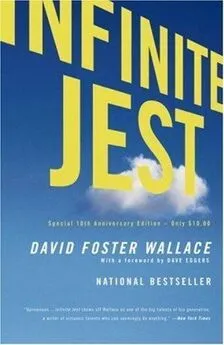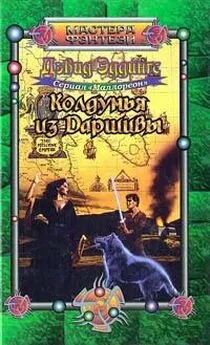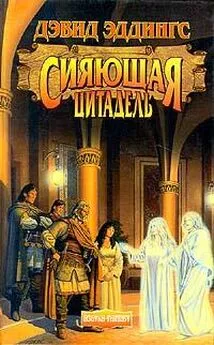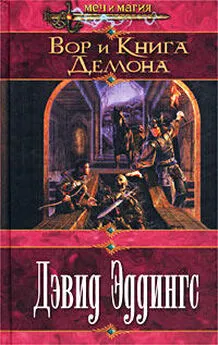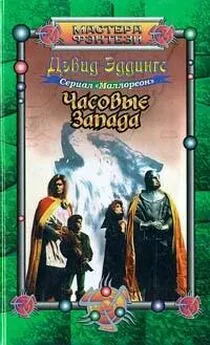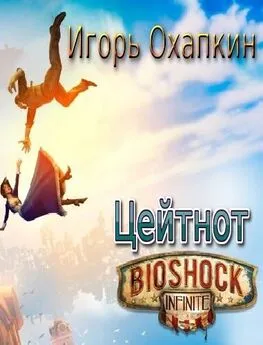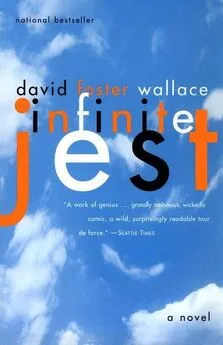David Wallace - Infinite jest
- Название:Infinite jest
- Автор:
- Жанр:
- Издательство:Back Bay Books
- Год:2006
- ISBN:нет данных
- Рейтинг:
- Избранное:Добавить в избранное
-
Отзывы:
-
Ваша оценка:
David Wallace - Infinite jest краткое содержание
Infinite Jest is the name of a movie said to be so entertaining that anyone who watches it loses all desire to do anything but watch. People die happily, viewing it in endless repetition. The novel Infinite Jest is the story of this addictive entertainment, and in particular how it affects a Boston halfway house for recovering addicts and a nearby tennis academy, whose students have many budding addictions of their own. As the novel unfolds, various individuals, organisations, and governments vie to obtain the master copy of Infinite Jest for their own ends, and the denizens of the tennis school and halfway house are caught up in increasingly desperate efforts to control the movie — as is a cast including burglars, transvestite muggers, scam artists, medical professionals, pro football stars, bookies, drug addicts both active and recovering, film students, political assassins, and one of the most endearingly messed-up families ever captured in a novel.
On this outrageous frame hangs an exploration of essential questions about what entertainment is, and why it has come to so dominate our lives; about how our desire for entertainment interacts with our need to connect with other humans; and about what the pleasures we choose say about who we are. Equal parts philosophical quest and screwball comedy, Infinite Jest bends every rule of fiction without sacrificing for a moment its own entertainment value. The huge cast and multilevel narrative serve a story that accelerates to a breathtaking, heartbreaking, unfogettable conclusion. It is an exuberant, uniquely American exploration of the passions that make us human and one of those rare books that renew the very idea of what a novel can do.
Infinite jest - читать онлайн бесплатно полную версию (весь текст целиком)
Интервал:
Закладка:
Thus there came to be, in most every tournament with an initial draw of 64, a group of three boys, then four, and by the semifinals five, then finally six boys who for that tournament formed the Clipperton Brigade, players who’d had the misfortune to draw and meet Eric Clipperton and Clipper-ton’s well-oiled Clock 17, and who understandably declined to be the player to cause Clipperton to eliminate his own map for keeps in public for something as comparatively cheesy as a tournament win over Clipperton. A win over Clipperton had no meaning because a loss to Clipperton had no meaning and didn’t hurt anybody’s regional and U.S.T.A. ranking, not once the guys in the U.S.T.A. computer center caught on to the Clipperton strategic M.O. Thus an early exit from a tournament because of a loss to Clipperton came to be regarded as sort of like a walk in baseball, stats-wise; and a boy who found himself in the Clipperton Brigade and defaulted his round tended to view that tournament as a kind of unexpected vacation, a chance to rest and heal, to finally get some sun on the chest and ankles, to work on chinks in his game’s armor, to reflect a little on what it all might mean.
Clipperton’s first meaningless victory ever came at sixteen, unseeded, at the Hartford Jr. Open, first round, against one Ross Reat, of Maddox OH and the just-opened Enfield Tennis Academy. For some reason it’s Struck who sort of specializes in this story and never misses a chance to tell new E.T.A.s the tale of Clipperton v. Reat. Clipperton’s an OK player, nothing spectacular but also not like absurdly out of place at a regional-grade tourney; but Reat is at fifteen seasoned and high-ranked, and the third seed at Hartford; and Reat is, for a while — as would be S.O.P. for a high seed in the first round — basically cleaning under his nails with this unseeded unknown Eric Clipperton. At 1–4 in the second set, Clipperton sits down at the side-change and, instead of toweling off, reaches into his gear bag and extracts his classy little blond-wood case and gets out the Clock 17. Fondles it. Takes out the clip and hefts it and rams it home in its slot at the base of the grip with a chillingly solid-sounding click. Caresses his left temple with the thing’s blunt shiny barrel. Everybody watching the match agrees it is one ugly and all-business-looking piece of personal-defense hardware. Clipper-ton climbs up the rungs of the lifeguardish chair the umpire in his blue blazer [158]sits in and uses the umpire’s mike to make public his intention of blowing his personal brains out all over the court with the hideous Clock, should he lose. The small first-round gallery stiffens and inhales and doesn’t exhale for a long time. Reat audibly gulps. Reat is tall, densely freckled, a good kid, one of Incandenza’s fair-haired boys, not too bright, with the Satellite Tour so clearly in his future that at only fifteen he’s already starting cholera shots and mastering Third World exchange rates. And but for the remainder of the match (which lasts exactly eleven more games) Clipperton plays tennis with the Clock 17 held steadily to his left temple. The gun makes tossing kind of a hassle, on Clipperton’s serve, but Reat is letting the serves go by untouched anyway. None of the E.T.A. staff has bothered to show up and coach Reat through what was supposed to be a standard first-round fingernail-cleaning, and so Reat is strategically and emotionally all alone out there, and he’s opted for not even pretending to make an effort, given what the unseeded Clipperton seems willing to sacrifice for a win. Ross Reat was the first and last junior player ever to shake Clipperton’s free hand at the end of a match, and the moment’s captured in a Hartford Cou-rant staff photo that some E.T.A. wiseacre’d later glued to the door of Struck’s room with so much Elmer’s all over the back that taking it off would gut the varnish, so the thing stays up for all in the hall to see, Reat here up at net on one knee, one arm over his eyes, the other hand extended upward to a Clipperton who’d simply obliterated him psychologically. And Ross Reat was never quite exactly the same ever again after that, both Schtitt and de Lint have assured all future potentially mercy-minded E.T.A. males.
And, the legend’s story goes, Eric Clipperton never henceforth loses. No one is willing to beat him and risk going through life with the sight of the Clock going off on his conscience. Nobody ever knows where Clipperton comes from, to play. Never seen at airports or Interstate exit ramps or ever even spotted carb-loading at any Denny’s between matches. He just starts materializing, always alone, at increasingly high-level junior tournaments, appears on draw-sheets with ‘Ind.’ by his name, plays competitive tennis with a Clock at his left temple; [159]and his opponents, unwilling to sacrifice Clipperton’s hostage (Clipperton même), barely even try, or else they go for impossible angles and spins, or else talk on mobile phones while they play or try to hit every ball between their legs or behind their backs; and the matches’ galleries tend to boo Clipperton just as much as they dare; and Clipperton sits and hefts his 17-shot clip and takes the brass-jacketed 9-mm. cartridges out sometimes and clicks a few together ruminatively in his hand in the sideline chair at all the odd-game breaks, and sometimes he tries little Western-gunslinger triggerguard-spins during the breaks; but when play resumes Clipperton’s deadly serious once more and has the Clock 17 at his temple, playing, and mows through the lackadaisical Clipperton Brigade round by round, and wins the whole tournament by what is essentially psychic default, and then right after collecting his trophy vanishes like the ground itself inhaled him. His only even remote friend on the jr. tour is eight-year-old Mario Incandenza, whom Clipperton meets because, even though Disney Leith and an early prorector named Cantrell are shepherding the male tournament contingent (including a solid but sort of plateau-stuck and no longer much improving seventeen-year-old Orin Incandenza) that summer, E.T.A. Headmaster Dr. J. O. Incandenza shows up at quite a few of the events on the domestic circuit, doing under ostensible U.S.T.A. auspices a two-part documentary on jr. competitive tennis, stress, and light, and so Mario’s tottering around with lens-cases and Tuffy tripods etc. at most of that late summer’s meaningful events, and meets Clipperton, and finds Clipperton intriguing and in ways he can’t be very articulate about hilarious, and is kind to him and seeks out his company, Clipperton’s, or at any rate at least treats Clipperton like he exists, whereas by late July everybody else’s attitude toward Clipperton resembled that kind of stiffly conspicuous nonrecognition that e.g. accompanies farts at formal functions. One of Himself’s short test-cartridges — shot to check out transverse aberration at various sun-angles, the case’s little adhesive sticker says — contains the only available footage of the late Eric Clipperton [160]— from the preponderance of salt-tablet dispensers and littered Pledge husks and Dade County ambulances it was pretty likely shot at the hideous Sunkist Jr. Inv. cramp-fest in August in Miami — just a couple overexposed meters of Clipperton, head down and hunched on a low orange bleacher, bony-shouldered, in no shirt and untied Nikes, his Gothic-scripted case in his lap, his elbows on his knees and his hands spidered across both cheeks, staring down between his feet and trying not to smile as a withered-toddler-sized and forward-listing Mario stands beside him, supported by his portable police lock, holding a light-meter and something else too halated to make out on the tape, open very wide for a homodontic laugh at something funny Clipperton has apparently just let slip.
Hal, having smoked cannabis on four separate occasions — twice w/ others — on this continental day of rest, plus still in a kind of guiltily sickening stomach-pit shock from the afternoon’s Eschaton debacle and his failure to intervene or even get up out of his patio-chair, Hal has lost a bit of his grip and has just gotten on the outside of his fourth chocolate cannoli in half an hour, and is feeling the icy electric keening of some sort of incipient carie in the left-molar range, and also now as usual, after swinishness with sugar, finds himself sinking, emotionally, into a kind of distracted funk. The puppet-film is reminiscent enough of the late Himself that just about the only more depressing thing to pay attention to or think about would be advertising and the repercussions of O.N.A.N.ite Reconfiguration for the U.S. advertising industry. Mario’s film executes some rather over-arty flash-cuts between the erections of Lucite fortifications and ATHSCME and E.W.D. displacement installations along the new U.S. border, on the one hand, and the shadowily implied Rodney-Tine-disastrous-love-interest element with the voluptuous puppet representing the infamous and enigmatic Québecois fatale known publicly only as ‘Luria P-----,’ on the other.
Tine’s puppet’s tiny brown felt hand is on Luria’s voluptuously padded little Popsicle-stick knee in the famous Vienna, Virginia Szechuan steakhouse where, according to dark legend, Subsidized Time was conceived on the back of a chintzy Chinese-zodiac paper placemat, by R. Tine. Hal happens to know the fall and rise of millennial U.S. advertising exceptionally well, because one of the only two academic things he’s ever written about anything even remotely filmic [161]was a mammoth research paper on the tangled fates of broadcast television and the American ad industry. This was the final and grade-determining project in Mr. U. Ogilvie’s year-long Intro to Entertainment Studies in May of Y.P.W.; and Hal, a seventh-grader and only up to R in the Condensed O.E.D., wrote about TV-advertising’s demise with a reverent tone that sounded like the events had taken place at the misty remove of glaciers and guys in pelts instead of just four years prior, more or less overlapping with the waxing of the Gentle Era and Experialist Reconfiguration Mario’s puppet-show makes fun of.
There’s no question that the Network television industry — meaning, since PBS is a whole different kettle, the Big Three plus the fast-starting but low-endurance Fox — had already been in serious trouble. Between the exponential proliferation of cable channels, the rise of the total-viewer-control hand-held remotes known historically as zappers, and VCR-recording advances that used subtle volume- and hysterical-pitch-sensors to edit most commercials out of any program taped (here a rather chatty digression on legal battles between Networks and VCR-manufacturers over the Edit-function that Mr. O. drew a big red yawning skull next to, in the margin, out of impatience), the Networks were having problems drawing the kind of audiences they needed to justify the ad-rates their huge overhead’s slavering maw demanded. The Big Four’s arch-foe was America’s 100-plus regional and national cable networks, which, in the pre-millennial Limbaugh Era of extraordinarily generous Justice Dept. interpretation of the Sherman statutes, had coalesced into a fractious but potent Trade Association under the stewardship of TCI’s Malone, TBS’s Turner, and a shadowy Albertan figure who owned the View-Out-the-Simulated-Window-of-Various-Lavish-Homes-in-Exotic-Locales Channel, the Yuletide-Fireplace Channel, CBC–Cable’s Educational Programming Matrix, and four of Le Groupe Video-iron’s five big Canadian Shop-at-Home networks. Mounting an aggressive hearts-and-minds campaign that derided the ‘passivity’ of hundreds of millions of viewers forced to choose nightly between only four statistically pussified Network broadcasters, then extolled the ‘empoweringly American choice’ of 500-plus esoteric cable options, the American Council of Disseminators of Cable was attacking the Four right at the ideological root, the psychic matrix where viewers had been conditioned (conditioned, rather deliciously, by the Big Four Networks and their advertisers themselves, Hal notes) to associate the Freedom to Choose and the Right to Be Entertained with all that was U.S. and true.
Читать дальшеИнтервал:
Закладка:
